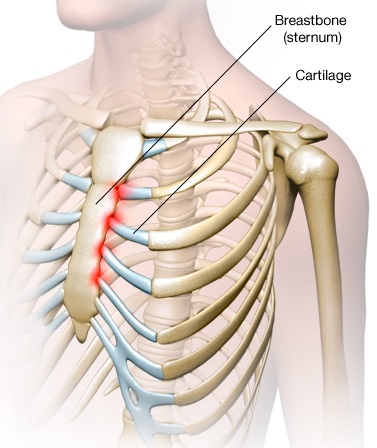Tietze, a German surgeon, first described this problem of pain in the rib joints at the front of the chest in 1921. While they are closely related clinical problems they may be separate conditions.
What is Costochondritis?
Costochondritis involves pain and inflammation in the joints between the ribs and the costal cartilages. The costal cartilages are part of the rib cage and connect the ribs to the sternum in the centre of the chest. The most commonly affected are the second, third, fourth and fifth costochondral joints.
The swelling and redness of at least one joint is required to qualify for being Tietze syndrome, which is a more acute diagnosis.
Who Gets Costochondritis?
This condition can occur in the very young and in adults of any age. Men and women are equally affected. In 90% of cases more than one joint is affected.
There can be many potential causes and doctors will check particularly to see if the patient has an arthritic condition of some kind.
Repeated minor trauma to the rib joints has been linked with this syndrome.
Costochondritis Symptoms
- Pain over the rib joints, can be mild to severe and vary
- Pain may radiate out from the rib joint areas
- Pain worse with coughing, exertion, trunk movements and breathing deeply
- The joint may swell and become reddened
- Pain may come and go and take years to settle completely
- Pain may return at another place unpredictably
- Functional activities involving arm use can be limited by pain
Treatment of Costochondritis and Tietze Syndrome
As the cause and prognosis of these conditions is often not clear, physiotherapy involves helping patients with their symptoms and minimising aggravation of the pain.
Physiotherapy for Costochondritis
- An explanation of the condition reassures a patient that they have a troublesome but non-progressive condition
- Postural advice may be given
- Exercises for the shoulders and chest are performed but should not be painful or worsening is possible
- Stretching of the pectoralis major muscle may be useful
- Heat and cold may be used as per the patient’s preference
- TENS and acupuncture
- Pain management techniques as the problem may continue to occur over a long period
References:
- Costochondritis – MedlinePlus – https://www.nlm.nih.gov/medlineplus/ency/article/000164.htm
- Costochondritis – Medscape – http://emedicine.medscape.com/article/808554-overview
Last Review Date: 15-10-2017
Next Review Date: 15-10-2019

